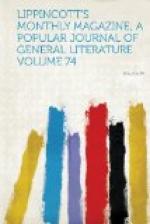E. C. R.
A LETTER FROM HAVANA.
HAVANA, Feb. 14, 1875.
It is not a very long sail from home to Cuba—you pass into the Bay of Havana on the morning of the fifth day, if you have luck—but the sky and land you left behind at this wintry season at home are very different from those you find on arriving here. It is a great change in so short a time from the dun-colored shore and the frozen river to the waving verdure of the Cuban coast and the sparkling blue and white of the water. We made the land before daylight, and, the rules forbidding us to enter the harbor till sunrise, we bobbed up and down for two or three hours a mile or so outside of the Moro Castle, which guards the narrow entrance to Havana. The moon was so brilliant that we did not have to wait for day to enjoy the scene before us: in fact, it could not have been improved by the sun. The fortress of Moro crouches on a bed of rock, rearing a tall lighthouse aloft. Its Moorish turrets have a soft rounded outline, and the undulations of the shore blend with the masonry of the castle; only a sharp retiring angle here and there gives an occasional glimpse of a grim purpose. When the Moro light is put out, ships in the offing may enter the bay. The mouth of the harbor is not more than half a mile wide, and on the shore opposite to the Moro the town of Havana comes down to the water’s edge, withdrawing up the bay on one hand, and up the sea-coast on the other. A pilot is not necessary except for the perquisites of office, but one comes on board, and with anxious countenance directs the ship straight on through clear water for a mile, when the anchor is dropped.
Just as day breaks on the high ground on the Moro shore, and the growing light brings houses and trees and ships into relief, with all their rich variety of color, the scene is memorable and full of beauty. On the green slope behind the castle, while the outline of the tropical vegetation is only stealing into view, there is hid, and yet visible, a long, low building of yellow columns, blue facade, brown gables and red tiles: if you shut out the rest of the landscape with your hands, you would say it was a picture by




